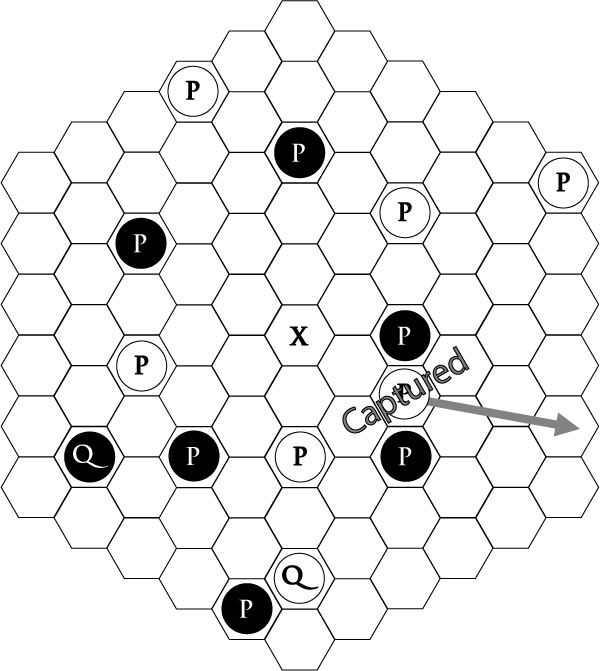A blog of tips and recommendations for anyone interested in learning or teaching mathematics.
Thursday, December 18, 2014
Rules of Kruzno -- updated
I've been alluded quite a bit to Kruzno, a game I developed a few years ago and which I am currently selling on Amazon, but I don't think I've ever posted the rules so here they are.
[Just to be clear, When you jump over a piece that you don't capture (for example, a white rook jumping a black rook), the piece that you jumped stays on the board.]
Sunday, December 14, 2014
Hexagonal chess
As mentioned before,I recently opened an Amazon store for the board game Kruzno. The game was configured to be suitable for a wide range of games. The best known of these was probably developed by Wladyslaw Glinksi in 1936. Glinski's Chess is one of the most popular chess variants with more than a half million players worldwide.
You can find rules many places online, but the following should be enough to get you started.
You can find rules many places online, but the following should be enough to get you started.
Monday, December 8, 2014
Agon
[I recently opened an Amazon store for the board game Kruzno. One of the considerations when developing the game was to configure the so that it could serve as a good utility player, suitable for a wide range of games. My favorite of these non-Kruzno games is probably Agon. It's a challenging but easy to learn game that's deserves a much bigger following. Here is the write-up I did of the rules a few years ago. You can play it on a Kruzno board, of course, but any standard hex board will do.]
Agon may be the oldest abstract strategy game played on a 6 by 6 by 6 hexagonally tiled board, first appearing as early as the late Eighteenth Century in France. The game reached it greatest popularity a hundred years later when the Victorians embraced it for its combination of simple moves and complex strategy.
The Pieces: Each player has one queen and six pawns a.k.a. guards placed in the pattern indicated below

The Objective: To place your queen in the center hexagon and surround her with all six of her guards.(below)


Moves: Think of the Agon board as a series of concentric circles (see above). Pieces can move one space at a time either in the same ring or the ring closer to the center. In the figure on the left, a piece on a hexagon marked 4 could move to an adjacent hexagon marked either 4 or 3. Only the queen is allowed to move into the center hexagon. The figure below shows possible moves.

Capturing: A piece is captured when there are two enemy pieces on either side of it. The player with the captured piece must use his or her next move to place the captured piece on the outside hexagon.

If the captured piece is a guard, the player whose piece was captured can choose where on the outer hex to place the piece. If the piece is a queen, the player who made the capture decides where the queen should go.
If more than one piece is captured in one turn, the player whose pieces were captured must move them one turn at a time.
If a player surrounds the center hexagon with guards without getting the queen into position, that player forfeits the game.
Agon may be the oldest abstract strategy game played on a 6 by 6 by 6 hexagonally tiled board, first appearing as early as the late Eighteenth Century in France. The game reached it greatest popularity a hundred years later when the Victorians embraced it for its combination of simple moves and complex strategy.
The Pieces: Each player has one queen and six pawns a.k.a. guards placed in the pattern indicated below

The Objective: To place your queen in the center hexagon and surround her with all six of her guards.(below)


Moves: Think of the Agon board as a series of concentric circles (see above). Pieces can move one space at a time either in the same ring or the ring closer to the center. In the figure on the left, a piece on a hexagon marked 4 could move to an adjacent hexagon marked either 4 or 3. Only the queen is allowed to move into the center hexagon. The figure below shows possible moves.

Capturing: A piece is captured when there are two enemy pieces on either side of it. The player with the captured piece must use his or her next move to place the captured piece on the outside hexagon.

If the captured piece is a guard, the player whose piece was captured can choose where on the outer hex to place the piece. If the piece is a queen, the player who made the capture decides where the queen should go.
If more than one piece is captured in one turn, the player whose pieces were captured must move them one turn at a time.
If a player surrounds the center hexagon with guards without getting the queen into position, that player forfeits the game.
Subscribe to:
Posts (Atom)





